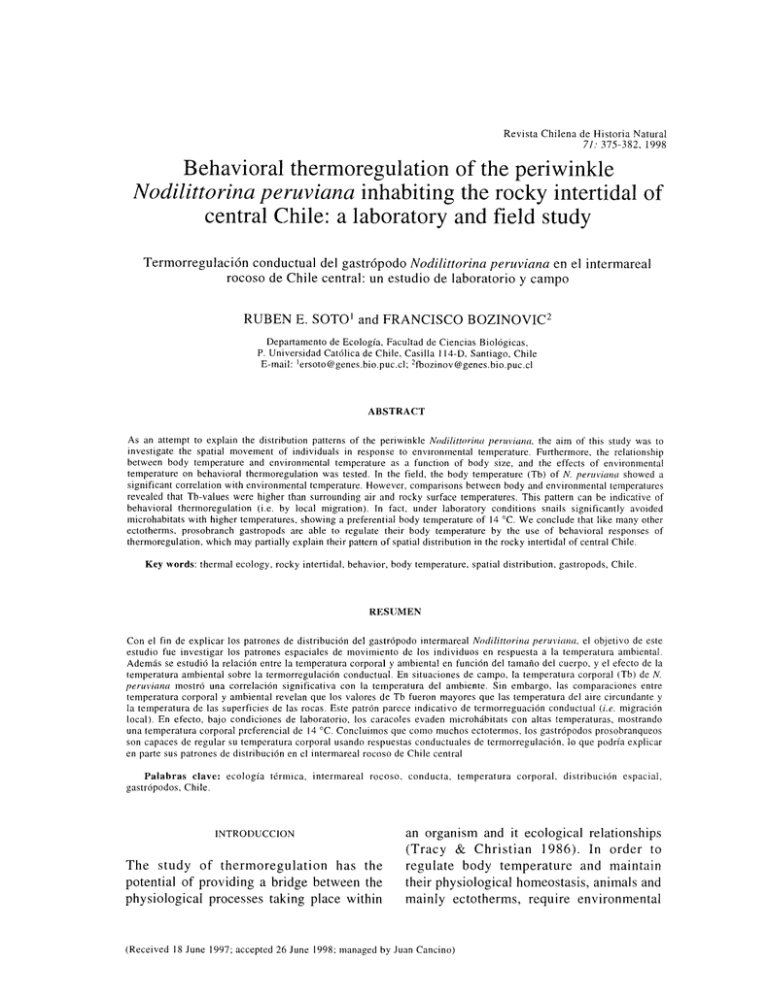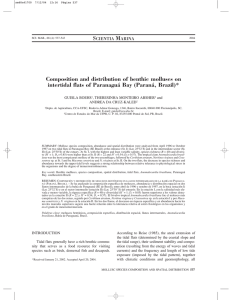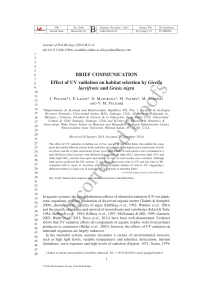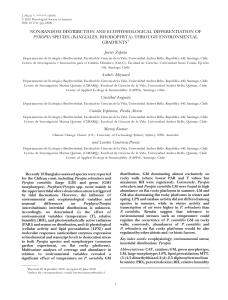Behavioral thermoregulation of the periwinkle Nodilittorina
Anuncio

Revista Chilena de Historia Natural 71: 375-382, 1998 Behavioral thermoregulation of the periwinkle Nodilittorina peruviana inhabiting the rocky intertidal of central Chile: a laboratory and field study Termorregulaci6n conductual del gastr6podo Nodilittorina peruviana en el intermareal rocoso de Chile central: un estudio de laboratorio y campo RUBEN E. SOTO¹ and FRANCISCO BOZINOVIC 2 Departamento de Ecologfa, Facultad de Ciencias Biol6gicas, P. Universidad Cat6lica de Chile, Casilla 114-D. Santiago, Chile E-mail: 1ersoto@ genes. bio. puc.cl: 2 fbozinov@ genes. bio. puc .cl ABSTRACT As an attempt to explain the distribution patterns of the periwinkle Nodi!ittorina peruviana, the aim of this study was to investigate the spatial movement of individuals in response to env1ronrnental temperature. Furthermore, the relationship between body temperature and environmental temperature as a function of body size, and the effects of environmental temperature on behavioral thermoregulation was tested. In the field, the body temperature (Tb) of N. peruviana showed a significant correlation with environmental temperature. However, comparisons between body and environmental temperatures revealed that Tb-values were higher than surrounding air and rocky surface temperatures. This pattern can be indicative of behavioral thermoregulation (i.e. by local migration). In fact, under laboratory conditions snails significantly avoided microhabitats with higher temperatures, showing a preferential body temperature of 14 °C. We conclude that like many other ectotherms. prosobranch gastropods are able to regulate their body temperature by the use of behavioral responses of thermoregulation, which may partially explain their pattern of spatial distribution in the rocky intertidal of central Chile. Key words: thermal ecology, rocky intertidal, behavior, body temperature, spatial distribution. gastropods, Chile. RESUMEN Con el fin de explicar los patrones de distribuci6n del gastr6podo intermareal Nodilittorina peruviana, el objetivo de este estudio fue investigar los patrones espaciales de movimiento de los individuos en respuesta a Ia temperatura ambiental. Ademas se estudi6 Ia relaci6n entre Ia temperatura corporal y ambiental en funci6n del tamaño del cuerpo, y el efecto de Ia temperatura ambiental sobre Ia termorregulaci6n conductual. En situaciones de campo, Ia temperatura corporal (Tb) deN. peruviana mostr6 una correlaci6n significativa con Ia temperatura del ambiente. Sin embargo, las comparaciones entre temperatura corporal y ambiental revelan que los valores de Tb fueron mayores que las temperatura del aire circundante y Ia temperatura de las superficies de las rocas. Este patron parece indicativa de termorreguaci6n conductual (i.e. migraci6n local). En efecto, bajo condiciones de laboratorio, los caracoles evaden microhabitats con altas temperaturas, mostrando una temperatura corporal prcferencial de 14 oc. Concluimos que como muchos ectotermos, los gastr6podos prosobranqueos son capaces de regular su temperatura corporal usando respuestas conductuales de tcrmorregulaci6n. lo que podrfa explicar en parte sus patrones de distribuci6n en cl intermareal rocoso de Chile central Palabras clave: ecologfa térmica. intermareal rocoso. conducta. temperatura corporal. distribuci6n espacial, gastr6podos, Chile. INTRODUCCION The study of thermoregulation has the potential of providing a bridge between the physiological processes taking place within an organism and it ecological relationships (Tracy & Christian 1986). In order to regulate body temperature and maintain their physiological homeostasis, animals and mainly ectotherms, require environmental (Received 18 June 1997: accepted 26 June 1998: managed by Juan Cancino) 376 SOTO & BOZINOVIC thermal heterogeneity in time and space. As postulated by Tracy & Christian (1986), since space and time are ecological resources, they provide the units whereby the thermal environment can be quantified as a resource. Spatial patterns of distribution of rocky intertidal gastropods have been traditionally explained as a consequence of: a) abiotic factors such as desiccation and wave action (e.g., Branch 1981, Little & Stirling 1985, Chelazzi et al. 1988, Hobday 1995); and b) biotic factors, associated with intra- and interspecific interactions (e.g., Wootton 1993, Menge 1995). Traditionally, the upper boundaries of distribution of high rocky intertidal species have been explained by physical factors acting during tidal emersion, whilst biological factors are thought to influence the lower distribution boundaries of intertidal animals (Underwood & Denley 1984, Paine 1994). Here we examine the relationships between the thermoregulatory processes and thermal environment under field and laboratory conditions in the periwinkle (Nodilittorina peruviana) inhabiting the rocky intertidal of central Chile. Prosobranch gastropods of the family Littorinidae have been used as a model to investigate the role of biological and physical stress on distributional patterns of intertidal organisms over ecological and evolutionary time (Gendron 1977, Boulding & Van Alstyne 1993, Chapman & Underwood 1996). The most important biological factors determining littorinid distribution include: food preference, competition, and predation (Underwood & McFadyen 1983). While, the main physical factors affecting patterns of spatial distribution include: wave action, heat stress, desiccation, and availability of crevices and refuges (Atkinson & Newbury 1984, Garrity 1984, Chapman & Underwood 1994). Investigations dealing with patterns of distribution of intertidal animals in the temperate Southern Pacific zone have been centered on the role of biotic factors (Castilla & Paine 1987, Santelices 1990, Menge 1995). By contrast, the effects of abiotic factors have received little attention (but see Santelices et al. 1980, Cancino & Rojas 1986). In South America there have been no detailed accounts of the ecology of any littorinid species, although there have been descriptions of their general intertidal zonation and geographical distribution (Santelices 1980, Brattstrom & Johanssen 1983). Nodilittorina peruviana is one of the most common periwinkles of the upper intertidal zone in northern and central Chile (Santelices 1980). Sante! ices et al. ( 1986) studied seasonal patterns of distribution and abundance of N. peruviana in the intertidal rocky shores of central Chile, documenting a pronounced important effect of environmental temperature in the annual variation of spatial distribution of this species. As an attempt to explain the relationships between thermoregulation (Johnston & Bennett 1996) and pattern of spatial distribution of N. peruviana, the aim of this study was to determine: 1) thermal preferences, 2) the relationship between body temperature, environmental temperature and body mass, and 3) spatial movements of N. peruviana in response to the rock-surface temperature. MATERIAL AND METHODS Field measurements Field studies were conducted during winter and summer time of 1996, on rocky platforms at the high intertidal zone in Las Cruces (33° 30'S; 71° 38'W), central Chile. Detailed descriptions of the study region are in Santelices ( 1990). Body temperature (Tb) of N. peruviana through daytime, preferential body temperature (PBT, n = 30), air temperature (Ta, at I em above each snail), and rock surface temperature BEHAVIORAL THERMOREGULATION IN AN INTERTIDAL GASTROPOD (Ts) were measured by using a copperconstantan thermocouple digital thermometer (± 0.1 °C). Measurements were conducted every two hours for a period of 24 hours. To guarantee the independence of measurements, each snail was recorded only once. To examine the relationship between temperature preferences and body size in this species, Tb and body weight of 30 individuals were measured at 14:00 and 18:00 h, during winter time. To avoid hand warming, animals were manipulated with the same wire of the thermocouple. Wet weight, including shell was determined by using a field electronic balance (± 0.1 mg). Laboratory experiments Individuals used in laboratory experiments were collected in the high rocky intertidal zone during winter time at the same site where field measurements were conducted. Animals were transported to the laboratory (aquarium) where they were acclimated for at least one day before measurements were made. To determine the effects of rock surface temperature on the spatial distribution and Tb of N. peruviana, two rocky microhabitats were offered to 40 individuals, under two different experimental conditions: a) condition one, where both rocky microhabitats exhibited similar Ts ( 14.5 °C); and b) condition two, one of the microhabitats at Ts = 40 °C, and the other microhabitat Ts = 14.5 °C. A heat source was provided by a 250 W infrared lamp. To incorporate the temporal variability associated with the behavioral response, experiments were repeated three times. In order to determine substratum temperature preferences, multiple-choice experiments were conducted. A surface thermal gradient ranging from I 0 to 30 °C was established in an experimental aquarium of 180 x 70 x I 0 em. Groups of 40 snails were located in the center of the aquarium, place at which the highest surface temperature of the experimental system was recorded. Heat was supplied through a 250 W infrared lamp 377 located at 40 em above the surface of the aquarium. After two hours, both, spatial distribution of the individuals and selected Ts were recorded. This experiment was repeated five times. Due to the lack of independence among sites whitin the temperature gradient, the Friedman nonparametric test and then a multiple comparison test (Conover 1981, Roa 1992) was used to test for substratum temperature preferences. In order to prevent the possible influence of water loss (dissecation) on the snail bahavior, both laboratory experiments were carried out in a cold room with a high relative humidity and precaution was taken that a water film was always covering the experimental substrata. RESULTS Winter measurements of the die! variations in Tb of N. peruviana in the field, were positively correlated with air (Ta) and rock surface (Ts) temperatures (Pearson correlation coefficients = 0.98 and 0.81, respectively, p < 0.001; Fig 1). A linear relationship between Tb and Ts was observed (Fig. 2). However, mean Tb's were significantly higher than Ts (KruskalWallis test = 69.45; p < 0.001). On the other hand, interestingly, summer measurements of die! variations in Tb's in the field were significantly lower than Ts during day-time (Kruskal-Wallis test = 12.42; p <0.005, Fig. 2), but higher than Ts during the night (Kruskal-Wallis test = 33.45; p <0.001, Fig. 2). Observed Tb- values were positively correlated with body size (Fig. 3). In fact, at 14:00 h the correlation between Tb and body mass was 0.58 (p = 0.009), whilst a correlation coefficient of 0.71 (p = 0.0001) was obtained at 18:00 h (Fig. 3). The relationships between Tb and body mass for different day times showed non-significant differences between slopes (AN C O VA: F = 0.659; df = I, 56; p = 0.42); suggesting that the relationship between Tb and body mass is constant through daytime. 378 SOTO & BOZINOVIC 18 18 16 14 E 12 .. 18 22 24 2 4 ... E Winter 8 12 14 16 18 12 Winter 34 12 26 E 14 16 18 36 22 Ts = Tb 18 Summer 14 18 22 24 4 12 14 16 18 Time(h) Fig. 1: Die! variations in body temperature of the snails Nodilittorina peruviana and their relationship with the air and surface rock temperature during winter and summer. Many standard deviation arc within the points. Variaciones diarias en Ia temperatura corporal del caracol Nodilittorina peruviana y su relaci6n con Ia temperatura del aire y de Ia superficie de las rocas durante invierno v verano. En varios casos Ia desviaci6n estandar se encuentran dentro de los puntos. Higher Ts-values limited the spatial distribution of the intertidal snails (Fig. 4). In fact, significant differences were detected in the occupation of the microhabitat associated with differences in Ts (chi-square: 44.551, df: l, p < 0.001; Fig. 4). During the experiment of temperature selection, individuals of N. peruviana exhibited non random Ts preferences (Friedman test: T 2 = 2.837, k 1=10, k 2 = 40, p < 0.01). In this way, the null hypothesis of no thermal preferences was rejected (Fig. 5). Multiple comparison tests revealed that PBT in this species ranged from 14 to I 7 °C (Table 1). DISCUSSION The rocky intertidal is generally organized into different zones. One major 12 18 24 36 Rock-surface temperature Fig. 2: Relationship between body temperature (Tb) of Nodilittorina peruviana and surface rock temperature (Ts) during winter and summer. Dotted line indicates isothermal conditions, n = 360. Relaci6n entre Ia temperatura corporal (Tb) de Nodilittorina peruviana y Ia temperatura de Ia superfic de las rocas (Ts) durante invierno y verano. La linea punteada indica Ia condici6n isotermica, n = 360. cause of this zonation is widely assumed to be differential responses of the intertidal organisms to gradient of abiotic (physical and chemical) conditions. Tolerance of marine intertidal organisms to temperature, salinity, and desiccation can be correlated with their position in the intertidal through time (Johnson 1975). Intertidal organisms, such as N. peruviana, inhabiting the highest levels of the shore, must tolerate a harsh physical environment, but are seldom subject to interspecific interactions. because few other species are found in the same area (Santelices 1990). In the field, Tb of N. peruviana showed a significant relationship with environmental BEHAVIORAL THERMOREGULATION IN AN INTERTIDAL GASTROPOD 17.5 17.0 E r p n = = = 30 379 Experiment 1 Ts2 16.5 E h 16.0 14.5 16.0 1.2 E 15.3 1.4 1.6 - = = n= r p 15.5 14.5 14.5 Substrate temperature 15.5 - C) Fig. 4: Microhabitat use frequency by Nodilittorina peruviana under two rock surface temperature (Ts) conditions in a laboratory experiment. Experiment I: Ts habitat a = Ts habitat b ( 14.5 °C); while Experiment 2: Ts habitat a (40 °C) > Ts habitat b (14.5 °C) . Frccuencia de uso de microhabitats por Nodilittorina peruviana bajo dos condiciones de temperatura superficiales de Ia roca (Ts) en un experimento de laboratorio. Experimento I: Ts de habitat a = Ts de hábitat b (14,5 °C): mientras que Experirnento 2: Ts de hábitat a (40 °C)>Ts de hábitat b (14,5 °C) . h 15.0 Body Mass (g) 1.2 1.4 1.6 Fig. 3: Relationship between body mass and body temperature of Nodilittorina peruviana in the field. n = Q) Reiaci6n entre Ia masa corporal y Ia temperatura de cuerpo de Nodilittorina peruviana bajo condiciones de campo. Q) temperature. However, comparisons between body and environmental temperatures revealed that Tb-values were higher than surrounding Ta and Ts. This pattern can be indicative of behavioral thermoregulation, which is active local migration into the zone of preferential temperature. Now we offer the following explanations to the observed relationships between body temperature and environmental temperature in space and time (see Fig.!): a) during light-hours in winter, and in the absence of thermal stress, animals are probably selecting crevices and other sunny areas where conditions allow to maintain their body temperatures; b) during both winter and summer nights, the rocky surfaces exposed to solar radiation during the day are warmer than adjacent air (RE Soto Q) 12 14 16 18 22 24 26 28 Rock-surface temperature Fig. 5: Relative frequency distribution of surface rocky temperature preferences of Nodilittorina peruviana under laboratory conditions. Distribuci6n de frecucncias relativas en las preferencias por temperatura superficial de rocas por Nodilittorina peruviana bajo condiciones de laboratorio. personal observations). Thus, at night, the rock surfaces reradiate (long-wave radiation) to the environment generating gradients of temperature. Consequently, at night the organisms are able to find thermal patches where thermoregulation is possible; and c) the position that an organism occupies in the 380 SOTO & BOZINOVIC TABLE 1 Test for substratum temperature preferences by Nodilittorina peruviana in the laboratory experiment. The Friedman multiple comparison test was used, ns =non significantly differences,**= p < 0.01. Prueba para preferencias de temperatura de sustrato por Nodi!irtorina p e r u v i n a en un experirnento de lahoratorio. Se us6 la prueba de Friedman para comparaciones multiples. ns = difcrencias no significativas. ** = p < 0,01 Temperature Gradient ns 12 13 14 15 18 22 16 12 ns ns ns ns ns ** ** ** ** ** ns 24 26 27 28 29 ns ns ns ns ns ns ns ns ns ns ns ns ns ns ns ns ns ns ns ns ns ns ns ns ns ns ns ns ns ns ns ns ns ns ns ns ns ns ns ns ns ns ns ns ns ns ns ns ** ** ** ** ** ** ** ** ** ** ns ns ns ns ** ** ** ** ns ns ns ns ns ns ns ns ns ** ** ns ns ns ns ns ns ns ns ns ns ns ns ns ns ns ns ns ns 19 22 24 26 27 28 29 intertidal zone is often related to its behavioral response to light, temperature or desiccation. When exposed to summer lighthours and when the amount of solar radiation is high, these mobile animals can reduce thermal stress by selecting crevices and increasing local humidity gradient through clustering. This behavioral strategy allows the animals to maintain their body temperature, that is, a Tb below stressful environmental temperatures (see Fig. 2). In short, Tb was slightly higher or equal to Ts and Ta at night but lower than Ts during daytime, which strongly suggest behavioral thermoregulation. Furthermore, the positive relationship between Tb and body mass indicates that large snails are able to maintain a larger ns ns ns ns ns ns ns ** ns ns ns ** ns ns ** ns ns ** ** ns ns ns ns ns ns ns ns ns ns ns ns ns ns ns ns ns ns ns ns ns ns ns ns ns ns ns ns ns ns ns ns ns ns ns ns ns ns ns ns ns ns ns ns ns ns ns ns ns ns ns ns ns ns ns ns ns ns ns ns ns ns ns ns ns ns ns ns temperature differential between body and environment than smaller ones. Recently, Hobday ( 1995) studied body size variations of the intertidal gastropod Lottia digitalis and their relationship with migratory behavior. According to this author, at the upper limits of the intertidal, small animals with high surface-to-volume ratios are at a disadvantage in comparison to large animals. Consequently, small gastropods may be constrained to lower heights, leading to a size gradient with increasing tidal height. High Ts's may appear as a limiting factor on the spatial distribution of N. peruviana in the field. In fact, in the laboratory, snails significantly avoided high Ts microhabitats. Thus, the use of behavioral thermoregulation, including BEHAVIORAL THERMOREGULATION IN AN INTERTIDAL GASTROPOD preferences for particular substratum temperatures or changes in patterns of spatial distribution and/or aggregation, may allow avoidance of thermal stress (Gendron 1977, Chapman & Underwood 1994, Chapman & Underwood 1996). Also, substratum temperature may influence patterns of spatial distribution of snails over a longer temporal scale. Indeed, Santelices et al. (1986) described a seasonal variation in the vertical distribution of N. peruviana, characterized by a downward migration during late spring and summer. Based on our results, we postulate that seasonal migration could be associated to thermal ecology and behavioral thermoregulation. ACKNOWLEDGMENTS This work was conducted during the graduate program of RES, which acknowledge a doctoral fellowship of CONICYT. We appreciate comments of P.A. Camus, and two anonymous referees. Funded by FONDECYT 1950394 grant to FB and FONDECYT 2980020 to RES. We acknowledge computational (software and hardware) support of FONDAP O&BM, "Programa Cooperativo de Apoyo a Programas de Doctorado" LITERATURE CITED ATKINSON WD & SF NEWBURY (1984) The adaptations of the rough winkle. Littorina rudis, to desiccation and to dislodgment by wind and waves. Journal of Animal Ecology 53: 93-105. BOULDING EG & KL VAN ALSTYNE ( 1993) Mechanisms of differential survival and growth of two species of Littorina on wave-exposed and on protected shores. Journal of Experimental of Marine Biology and Ecology 169: 139-166. BRANCH GM (1981) The biology of limpets: physical factors. cncrg I y flow. and ecological interactions. Oceanography and Marine Biology Annual Review 19: 235-380. BRATTSTROM H & A JOHANSSEN ( 1983) Ecological and regional zoogeography of the marine benthic fauna of Chile. Sarsia 68: 289-339. CANCINO JM & M ROJAS ( 1986) Evaluaci6n del potencial de crccimicnto de Perumytilus purpuratus a distintas alturas en cl intcrmareal de Chile central. Medio Ambiente (Chile) 8: 27-32. 381 CASTILLA JC & RT PAINE ( 1987) Predation and community organization on Eastern Pacific, temperate zone, rocky intertidal shores. Revista Chilena de Historia Natural60: 131-151. CONOVER W J ( 1981) Practical non parametric statistics. John Wiley and Sons. New York. 394 pp. CHAPMAN MG & AJ UNDERWOOD (1994) Dispersal of the intertidal snail, Nodilittorina pyramidalis, in response to the topographic complexity of the substratum. Journal of Experimental Marine Biology and Ecology 179: 145-169. CHAPMAN MG & AJ UNDERWOOD (1996) Influences of tidal condition, temperature and desiccation on patterns of aggregation of the high-shore periwinkle, Littorina unifasciata, in New South Wales, Australia. Journal of Experimental Marine Biology and Ecology 196: 213-237. CHELAZZI G, S FOCARDI & JL DENEUBURG (1988) Analysis of movements patterns and orientation mechanisms in intertidal chi tons and gastropods. In: Chelazzi G M Vannini, (eds) Behavioural adaptation to intertidal life: 173-184. Nato ASI Series A, Life Sciences, Vol. 151, Plenum Publishing Corporation, London. GARRITY SD (1984) Some adaptations of gastropods to physical stress on a tropical rocky shore. Ecology 65: 559-574. GENDRON RP ( 1977) Habitat selection and migratory behaviour of the intertidal gastropod Littorina littorea (L.). Journal of Animal Ecology 46: 79-92. HOBDAY A ( 1995) Body-size variation exhibited by an intertidal limpet: Influence of wave exposure, tidal height and migratory behavior. Journal of Experimental Marine Biology and Ecology 189: 29-45. JOHNSON SE ( 1975) Microclimate and energy flow in the marine rocky intertidal. In: Gates DM & RB Schmerl (eds) Perspectives of biophysical ecology: 559-587 Springer-verlag, New York. JOHNSTON lA & AF BENNETT (1996) Animals and temperature: phenotypic and evolutionary adaptation. Cambridge University Press, Cambridge. 419 pp. LITTLE C & P STIRLING ( 1985) Patterns of foraging activity in the limpet Patella \'ulgata L. A preliminary study. Journal of Experimental Marine Biology and Ecology 80: 283-296. MENGE BA ( 1995) Indirect effects in a marine rocky intertidal interaction webs: patterns and importance. Ecological Monographs 65: 21-74. PAINE RT ( 1994) Marine rocky shores and community ecology: an experimentalist's perspective. Ecology Institute, Oldendorf/Luhe. xxii + 152 pp. ROA R ( 1992) Design and analysis of multiple-choice feedingpreference experiments. Oecologia 89: 509-515. SANTELICES B ( 1980) Muestreo cuantitativo de comunidades intermareales de Chile central. Archivos de Biologfa y Medicina Experimental 13: 413-424. SANTELICES B ( 1990) Patterns of organization of intertidal and shallow subtidal vegetation in wave exposed habitats of central Chile. Hydrobiologia 192:35-57. SANTELICES B, JC CASTILLA. J CANCINO & P SCHMIEDE ( 1980) Comparative ecology of Lessonia nigrescens and Durvillaea antarctica (Phaeophyta) in central Chile. Marine Biology 59: 119-132. SANTELICES B, J VASQUEZ & I MENESES ( 1986) Patrones de distribuci6n y dietas de un gremio de moluscos herbfvoros en habitats intermareales expuestos de Chile central. Monograffas Biol6gicas (Chile) 4: 147-171. 382 SOTO & BOZINOVIC TRACY CR & KA CHRISTIAN ( 1986) Ecological relationships among space. time. and thermal niche axes. Ecology 67: 609-615. UNDERWOOD AJ & EJ DENLEY (1984) Paradigms, explanations, and generalizations in models for the structure of intertidal communities on rocky shores. In: Strong, DR. D Simberloff, LG Abele & A Thistle (eds) Ecological communities: conceptual issues and the evidence: 151-180. Princeton University Press, New Jersey. UNDERWOOD AJ & KE McFADYEN ( 1983) Ecology of the intertidal snail Littorina acutispira Smith. Journal of Experimental Marine Biology and Ecology 66: 169-197. WOOTTON JT ( 1993) Indirect effects and habitat use in an intertidal community: interaction chains and interaction moditications. American Naturalist 141: 71-89.



